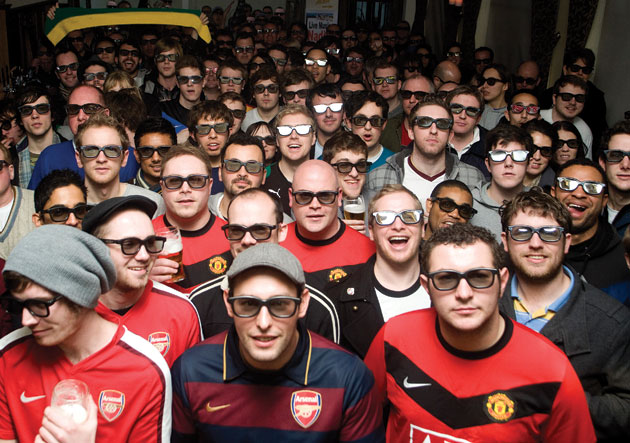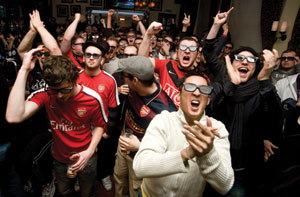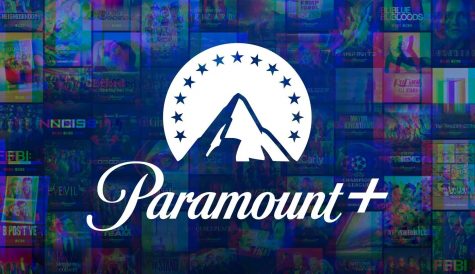
After more than 40 years of operation, DTVE is closing its doors and our website will no longer be updated daily. Thank you for all of your support.
The third dimension
BSkyB will launch a dedicated 3D TV channel this year. With other operators set to follow, Graham Pomphrey assesses broadcaster strategies and the latest technologies on offer for this much-hyped technology.
3D video has, until recently, been confined to the cinema. If you exclude the limited forays into anaglyphic technology, that is. You may know this better as the service that requires you to sport retro cardboard glasses with blue and red lenses to view a generally underwhelming 3D picture. Stereographic 3D technology, however, is the current darling of Hollywood and has boosted consumer awareness of and appetite for 3D immensely. Avatar has had the biggest impact on film goers, taking over US$2.5bn (€1.8bn) at the box office to-date, and highlighting consumer willingness to pay a premium to see the latest 3D technology in action. More recently, Tim Burton’s Alice in Wonderland took record opening takings for a 3D movie in North America with US$116.3m in its first weekend. But will the appetite translate to the small screen? UK pay-TV operator BSkyB certainly thinks so.
Sky 3D
Having broadcast the world’s first live 3D sports event earlier this year (see sidebar), it will become the first broadcaster to deliver a dedicated 3D channel later this year. Sky 3D will launch on a free basis to Sky’s top tier customers who also subscribe to its HD channel pack, meaning that it can reward premium customers or provide an enticement to others to upgrade, says Brian Lenz, Sky’s director of product design and TV product development. As the channel develops and scales over time, Sky will “keep its options open about other potential revenue streams.” As for content, Lenz admits that the initial lack of programming means the operator will focus on “quality over quantity” but it still plans to deliver live sports, movies and “at least one other appointment to view programme from entertainment, arts, documentaries and the like.” And looking forward, “as 3D starts to gain momentum internationally, and as other UK broadcasters hopefully come on board, we expect the channel to scale over time,” he says.
Whilst Sky was the first broadcaster to announce a 3D channel launch, others have followed – amongst them Canal Plus has plans to launch a service by the end of the year, Sky Deutschland recently broadcast a Bundesliga football match in 3D, and ESPN, Discovery and DirecTV in the US also have plans to launch services this year.
Technology choices
One of the most significant aspects of Sky’s announcement was that existing Sky Plus HD set-tops could, and would, be used to deliver 3D. Customers will still have to fork out for a 3D TV set but the decision means Sky will be able to lay claim to launching the world’s first commercial 3D channel. “Sky is launching a 3D service now as we’re seeing the coming together of a number of different threads which makes it possible from a content, technical and commercial perspective,” says Lenz. “From the technical perspective, we’ve seen the emergence of affordable, high-quality 3DTVs for image playback, along with specialist 3D camera rigs for image capture. And thanks to our ability to utilise our HD broadcast infrastructure, right up to and including our current generation Sky Plus HD box, the barriers to introduction have significantly reduced.”
“There are a number of candidate systems that work with existing set-top boxes. Opinions differ about which is best.”
David Wood, EBU Technical
While Sky and others will be seen as pioneers of 3D TV, the road to mass-market delivery will be long, not least because standards seem to be a way off being finalised and technology choices remain unclear. One of the most forward looking organisations, the ITU, recently outlined a roadmap for the future implementation of 3D TV. Study Group 6 of the ITU’s Radiocommunication Sector (ITU-R) proposes three successive generations or profiles for the development of stereoscopic 3D. The first, dubbed “plano-stereoscopic TV”, calls for two views to be delivered to TVs, with viewers wearing glasses akin to those used to watch 3D cinema at the moment. Viewers will be able to see depth in the picture, although the view will remain the same when they move their heads, unlike in real life.
The second generation (“multiview profile”), says the ITU, will provide for multiple views, meaning that head movement will change the view in a way that more closely mimics real life. Finally, the third generation (“object wave profile”) will feature systems that record the amplitude, frequency, and phase of light waves, to reproduce almost completely human beings’ natural viewing environment, according to the ITU. The report envisages that these kinds of advanced systems are some 15-20 years away.
For now, broadcasters seriously considering 3D are firmly focusing their attentions on stereoscopic technologies. Yet even within this technology choice there are a number of sub-technologies being explored. “The situation has been diverse for some years in the sense that there are quite a lot of organisations looking at 3D TV,” says David Wood, chairman of the ITU working party looking at common standards for 3D TV, and deputy director of EBU Technical. The ‘frame-compatible’ mode is likely to be favoured by pay-TV operators (including Sky) because of its ability to utilise existing HD set-top boxes. “Within this area, which is the most advanced in broadcasting terms, there are a number of candidate systems for working with existing set-top boxes. Opinions differ about which is best or will results in the best picture quality,” says Wood. One school of thought, shared by Sky, is that a system called side-by-side should be used. Here, a HD picture for each eye is delivered to existing HD set-top boxes, to which it appears as a normal HD signal, where they sit side by side. The 3D TV has the necessary technology to create left and right eye pictures with 3D glasses filtering out the correct image to each eye. “It’s not much of an additional cost in terms of manufacturing,” says Wood.
Another variant of frame-compatible, said to be favoured by ESPN, sees the left and right signals layered on top of each other. “Some feel the depth resolution would be better served by a top and bottom approach,” says Wood. “There is some difference in technical opinion. You might say it would be great if the industry could settle on one of these, but receivers could cope with both technologies. We might find ourselves in a world where both are used.”
Meanwhile, the so-called ‘service compatible’ system has been adopted by the Blu-ray Association, and delivers full HD 1080p resolution to each eye. “From a technological perspective, it is simply the best available platform for bringing 3D into the home,” said Benn Carr, chairman, Blu-ray Disc Association 3D task force. Sony has announced that its BDP-S470 Blu-ray disc player is now capable of showing 3D movies following a software download, and the latest in Sony’s range of Blu-ray players will be able to play 3D discs with no firmware upgrade.
The drawback, for pay-TV operators at least, is that this approach is not compatible with existing set-top boxes. Also, although not a broadcast system, it could also need nearly twice the bandwidth of a single HD signal, according to EBU Technical.
Aside from the Blu-ray Association, this service-compatible system has also been recommended to UK regulator Ofcom by consultancy Zetacast as the 3D TV broadcast standard it should work towards. The report predicted that the UK’s DTT network is likely to be able carry four 3D services in a single multiplex by 2020. “In principle, free-to air broadcasters are probably interested in this system because they don’t have an existing population of set-tops,”says Wood. “It could be some time away, not least because they’ll need to develop business models first.”
Lack of standards
According to Lenz, it was crucial that Sky could harness its current HD infrastructure for 3D: “It means we didn’t have prohibitive expenditure costs in the broadcast value chain which may have dampened our interest in exploring 3D. Instead, we’ve been able to work with the strength and versatility of our platform to deliver a high-quality 3DTV experience into the home.
“By using our existing HD infrastructure (from cameras right through to the in-home set-top box) we have been able to develop the new technology needed for a high-quality 3D service without starting from scratch and that means we can bring it to customers in a relatively short space of time. And with 2.1 million Sky Plus boxes already in homes, and with Sky having now standardised around a single box strategy, it means there’s no costly box swap out activity required.”
So how does the operator feel about launching a 3D service with clearly defines standards still waiting to develop? Sky is platform and technology-agnostic, says Lenz. The company has focused on using non-proprietary formats, within existing standards frameworks, he says: “Our choice to deliver 3D in side-by-side came from collaboration with the TV manufacturers to ensure that there would not be a case where Sky 3D does not work with a manufacturer’s TV,” he says. “We have chosen a format that is agnostic to the screen display technology — side-by-side will work with both passive and active glasses solutions, leaving the choice to consumers. And the formats we’re supporting are ultimately being adopted within the standards currently for HDMI 1.4. We pushed ahead because the solutions are here now and they work.”
However, over time, Lenz says the company recognises that as technology develops, the industry will be able to consider other ways of delivering 3D. “We are open minded to assessing the opportunities for that as and when they present themselves, and we will continue to work with the industry – and not least the DTG – to ensure that we play a full and active role in supporting further R&D.”
 Delivery
Delivery
While Sky may be the first out of the block to launch 3D commercially, and a handful of others are set to follow, most industry players will want a better understanding of the processes involved in transmitting 3D. All eyes will be on Sky’s service but more testing will be needed before others make the plunge into 3D. Satellite operator SES World Skies is conducting a series of 3D TV tests in conjunction with broadcasters, producers, TV makers and technology companies. While it will predominantly focus on the US market, content is likely to be shared between Europe and the US to test the various technologies on offer. According to Bryan McGuirk, senior vice-president of media solutions for SES World Skies, the aim is to facilitate the development of standards and best practice for all parts of the broadcast chain. “The mission is to pull adoption of 3D forward into the home,” he explains. “It’s obvious to people that are involved that there is no standard yet, the business models are still unclear and there really isn’t anywhere to try everything in a linear chain to make sure it works. There are many questions to be answered – when you look at frame-compatible 3D, for example, what’s the best way to transmit it? Is it side-by-side, above and below, interleave? There are numerous things to consider like frame rates and time codes – all are critical along the chain.”
“You don’t want to track your eye too much between two different depths – it can be a tiring process”
Kevin Murray, NDS
SES World Skies plans to carry out 3D tests until the end of the year. In Europe, broadcast services provider GlobeCast has already been involved in test transmissions for various events, including a live 3D HD feed of a performance of Mozart’s opera Don Giovanni from the Rennes Opera house in Brittany to French cinemas, last year’s Roland Garros tennis championships to cinemas on behalf of Orange and France Télévisions, and most recently a Burberry fashion show to parties in Dubai, New York, Paris and Tokyo. According to Simon Farnsworth, head of global contribution, the difference in delivering 3D content compared to HD, is minimal, aside from the compression techniques required for the two stereoscopic feeds. One method that involves encoding the streams separately and delivering them to a decoder could prove prohibitively expensive Farnsworth says. GlobeCast has trialled a contribution system using compression technology from ATEME that involves encoding both streams and multiplexing them to save on bandwidth. “We used this method for the Roland Garros tournament and found it to be more cost-effective,” says Farnsworth.
So far the trials have gone well, he says but broadcasters in the main are showing limited interest in launching commercial services. This is, in part, a result of bandwidth issues, despite the fact that a dedicated 3D channel would not require any more than a HD channel. “It’s the same as with HD. It’s not really going to take off unless there’s less bandwidth and despite the number of deployed MPEG-4 receivers continuing to grow, until platforms move over fully to MPEG-4 the costs will remain high.”
Graphics
Another issue for 3D that mirrors the HD world is the supply of satellite capacity available, despite operators busily launching new satellites. The boom in HD channel launches coupled with the growth in digital channels generally means that satellite operators are working hard to find new capacity with new satellite launches. According to McGuirk, it’s too early to tell what the capacity constraints relating to 3D TV will be. This why, he says, it is in everyone’s interest to find the most efficient technologies for 3D: “It’s early to speculate on capacity but we’ll be testing different bandwidths. The goal is to optimise it and make it as accessible for business models as possible because we want to pull forward adoption of 3D.” From a visual point of view, one of the often overlooked issues for broadcasters to consider is the importance of getting the graphics right. At Sky’s broadcast in January, people were quick to praise the quality of graphics, especially the team line-ups. However, it’s not as straightforward as it seems and companies are working hard to optimise to the look and feel of graphics. NDS is one such company. Systems architect Kevin Murray explains some of the hurdles companies like NDS are trying to overcome: “There is a clear issue of where to place graphics. We try to avoid bringing things too far forward, for example – some people are fine with it, some people aren’t – it’s all a learning curve,” says Murray. In the shot selection of a sports broadcast, for example, decisions about where to place graphics can be made in advance. In the set-top box, however, it’s more of a challenge because graphics can appear at any time, from the EPG to menus or error messages. One solution NDS is considering involves depth information about the picture being broadcast to the set-top box, which can then make the necessary alterations to graphics. “Because we’re talking about stereoscopic 3D, you have perceived depth depending on how the images are offset. If you know the offset value you can work out where to place a graphic at a given location. It’s a simple bit of information to send but receiving it is not so easy. It makes more sense to do as much of the work at the headend so you would send some very simple information for the set-top to use.”
Another graphics-related concern for 3D is subtitles. “Looking at the subtitles and then back to main screen is a challenge. You don’t want to track your eye too much between two different depths because it can be a very tiring process. It’s an interesting area,” says Murray. Which brings in another issue: what impact will 3D have on the visually impaired?
“There is no certainty that there will be a problem but I would like to see more information about the issue of eye fatigue,” says Wood. “There are also concerns about how much we know about the proportion of people that won’t be able to fuse the left and right eye pictures together – will it be one per cent or five per cent?”
[icitspot id=”9426″ template=”box-story”]
There are many questions left to be answered when it comes to 3D – will operators be prepared to invest in new technology without clearly defined business models in place? Will viewers be prepared to wear 3D glasses at home? For how long will there be a dearth of 3D content? In the short term, one of the most pressing concerns is the willingness of consumers to fork out for new 3D ready TV sets. The race is already on between TV manufacturers to be amongst the first to market. Samsung could launch sets as early as the end of March, while Sony has confirmed it will offer a range of 3D TVs this June, with the 46-inch version costing ¥350,000 (€2,800), which is about 50% more than a top of the range HD LCD set. Despite Sony aiming for sales of 2.5 million 3D TV sets in the next financial year, only time will tell how willing people will be to invest.
All eyes will be on Sky this year, but if the tardy roll out of high-definition TV is anything to go by, don’t expect 3D TV to leap off the screen into the hearts and minds of TV consumers for some time.


